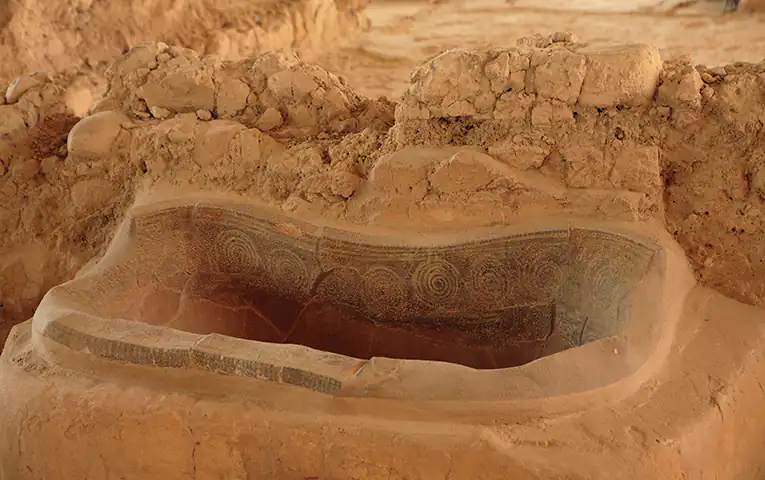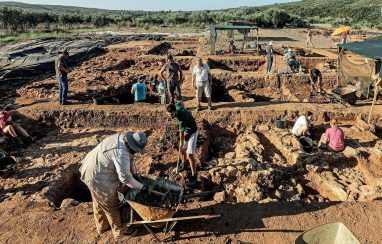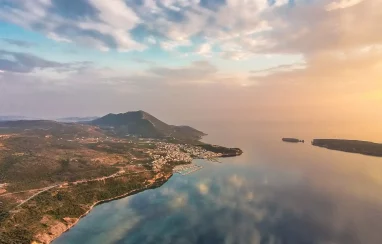By Alexandra Tzavella and Paulina Björk Kapsalis
The day after a visit to the Palace of Nestor, while lounging on my private terrace overlooking the enchanting Ionian Sea and the gardens and pools of The Westin Resort Costa Navarino, feeling much like a king myself, I thought of how Nestor, the King of Pylos, also chose to spend his days here, 3,000 years ago and just a few kilometers up the hill. Unlike other Mycenaean settlements, the Palace of Nestor was not fortified – an indication, I concluded, that just like today, this area was a peaceful, soul-soothing place.
Truth be told, I was surprised when I was told that this structure – once home to a character whom I’d only known as a mythical hero, someone who, in works by Homer and later Roman writers, had played a role in the Trojan War, the Centauromachy and the Voyage of the Argonauts – was real, and could be visited.
But his palace, a two-story structure, with tall doors and carved white benches on which he would sit to think, did exist, among the olive trees and with the sparkling sea in the distance, and much of it is still there today. I had seen the remains with my own eyes, and it is more than impressive. Heading there to see it is, in fact, one the best things to do in Messinia.
Today, the 3000-year-old archaeological site of the actual Palace of Nestor is a historical landmark, sheltered beneath a modern protective roof. On our arrival, we downloaded a digital tour onto our tablet, and walked along the elevated pathways, gazing down at the original floors, the ruined walls bearing traces of frescoes and the ancient bathtub where it’s entirely possible that Telemachus, the son of Odysseus, was bathed by Nestor’s daughter, Polykasti.
For many years, however, no one knew what was here. While others had previously pursued various clues hoping to find the legendary palace, it was Carl W. Blegen, an American archaeologist and University of Cincinnati professor, who, in collaboration with Greek archaeologist and academic Konstantinos Kourouniotis, made the great discovery less than a century ago.
Born in Minneapolis, Minnesota, to Norwegian immigrants, Blegen first came to Greece as a student at the American School of Classical Studies (ASCSA) in 1910. A year later, he visited Pylos by boat, arriving after a seven-hour voyage down the coast from Kyparissia. He worked on digs in Corinth and Cyprus, and later participated in excavations at Troy, but Athens was always his base. The western Peloponnese, however, the “unknown land” as he described it, was ever on his mind. Finally, in 1939, he returned to begin research with Kourouniotis, who had discovered royal tombs at the sites of Tragana and Koryfasio. Blegen was accompanied by his wife, Elizabeth, as well as by their close friends Burt and Ida Hill, also archaeologists, and Bill McDonald, an ASCSA student. Blegen’s first discovery at Kato Englianos turned out to be a large, rich and unplundered tholos tomb, and that was only the beginning.
In April 1939, during a period of spring rains in Messinia, Blegen found himself kneeling in the mud, carefully lifting out ancient artifacts. He had some difficulty doing this; he was working with only one arm, having lost the other in a hunting accident when he was just 15. Straight away, traces of the Mycenaean era began to appear: well-built walls, plaster floors, pottery and hundreds of tablets inscribed in Linear B – the first to be found on mainland Greece.
The fire that destroyed the palace had baked the tablets and, therefore, preserved them. When Blegen unearthed them, they were wet. “When we dried them on wire screens they became almost as hard as pottery, but still each tablet had to be cleaned, inch by inch, with toothpicks,” he recounted. “We didn’t dare use acid then as we do now. It was a chore… and we enjoyed every minute of it.”
World War II interrupted the excavation for some years, and the finds were transferred for safe-keeping to the basement of the National Bank in Athens, but Blegen returned with his team in 1952, and the excavation started again. New signs were put up and the palace finally revealed itself in full: the throne room; 105 other rooms; the staircase; the sewer system; the pantries with their 6,000 clay vessels and household utensils; and the storerooms for wine, olive oil and aromatic oils.

In the summer of 1955, the news of the discovery of a bathtub traveled around the world. In a lecture in Cincinnati, Blegen jested: “We know the tub we found was last used for its intended purpose approximately 1,200 years before the birth of Christ. Therefore, there seems to be no truth to the story that the bathtub was invented in Cincinnati a century or so ago.” In fact, Telemachus himself may have used that same bathtub when he visited Nestor’s palace seeking news of his father, still missing after the Trojan War.
Blegen left behind a great legacy, but there was still more to be found at the King’s palace. In the 1990s, more than twenty years after Blegen’s death, Jack Davis and Sharon Stocker, husband-and-wife archaeologists from the University of Cincinnati, would make a discovery that would change our understanding of the history of ancient art.
The pair had been participating in excavations in Greece since the 1970s, but, inspired by Blegen’s work, it was Pylos in particular that called to them. In 1992, they made a first, fruitless visit to the area. Everyone discouraged them as well, saying: “Whatever there was to find there, Blegen already found it.” Undaunted, they returned to Ano Englianos in May 2015, as part of a five-year excavation program of the University of Cincinnati.
Then the unthinkable happened. In an olive grove, a few short steps from the palace, they discovered an undisturbed tomb dating to about 1450 BC; it contained some of the most important prehistoric finds brought to light in mainland Greece in the last 65 years.
The tomb belonged to a 30 to 35-year-old warrior, who was dubbed the “Griffin Warrior” after an ivory plaque featuring an engraving of the mythical creature that was found in the grave. He was surrounded by riches: 1,800 valuable objects filled the tomb, including a 75cm-long gold chain, four gold seal rings with Minoan representations, ivory combs and over 1,000 exotic beads of gold, amethyst, agate, carnelian and glass. In addition, there was a mysterious object, just 3 centimeters in length.
The archaeologists were completely unprepared for what they saw when they placed that small object under a microscope. Before them was an agate seal stone, onto the surface of which was carved a sensational battle scene involving three warriors. Extraordinary details could be distinguished: lines defining muscles and facial expressions, the crest of a helmet, the pattern on a dead man’s garment, the bracelet and the necklace of the central figure.
The decoration of the seal stone, named the Pylos Combat Agate, contradicts what was previously understood about the history of art in the Aegean. Although produced prior to 1500 BC, during the early Mycenaean era, the scene contains elements previously associated exclusively with later eras. “Realism, a three-dimensional and extremely detailed presentation, and a sense of movement that we see present in the Archaic and Classical eras,” said Stocker. What’s depicted resembles a Trojan War scene from the Iliad – perhaps Achilles fighting over the body of the dead Patroclus. It’s likely that the seal stone represents a story that was well known to the inhabitants of the place where the object was produced. This was probably Crete, as seal stones from mainland Greece do not exhibit such features.
Having learned all of this, and more, I wondered what else might still lay undiscovered in the earth of the historic hills behind me. The work of the archaeologists continues, and there are still questions left unanswered at this Messinia landmark; could the hero that appears on the seal stone be identified as the deceased “Griffin Warrior” himself? Are there other tombs to be found? And what would Nestor, the brave, wise and well-spoken King of Pylos from whom all the Achaeans sought advice, have thought about all this as he gazed down the hill at this same glittering view?
[Edited version of an article published in Costa Navarino Stories, Issue 07]

